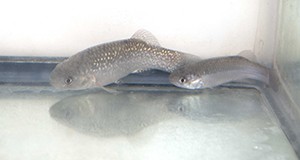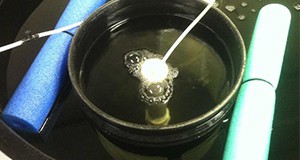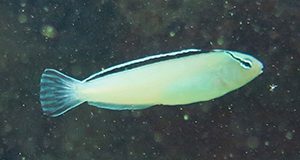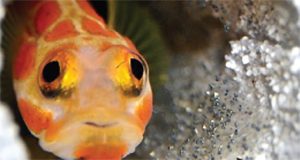Marine ornamental fish production is still in its infancy compared with its freshwater counterpart. About 1,800 wild-caught fish species are imported into the United States each year, clear proof of the need for the expansion of marine ornamental production to include new species and families of fish. Distinct behavior and a wide range of colors makes fish from the Blenniidae family, called blennies, a popular choice in the aquarium hobby. These hardy fish are small and rarely aggressive to other reef species and they eat algae and clean tank substrate. This 6-page fact sheet written by Jesse Von Linden, Joshua T. Patterson, Cortney L. Ohs, and Matthew A. DiMaggio and published by the UF/IFAS Program in Fisheries and Aquatic Sciences, School of Forest Resources and Conservation provides a brief overview of the family including description and taxonomy, natural history, culture techniques, a bit about disease challenges, and advice on marketing for ornamental Blennids.
https://edis.ifas.ufl.edu/fa225
Tag: Cortney L. Ohs
Aquaculture Applications of the Family Gobiidae
Marine ornamental fish production is still in its infancy compared with its freshwater counterpart. About 1,800 wild-caught fish species are imported into the United States each year, clear proof of the need for the expansion of marine ornamental production to include new species and families of fish. The family Gobiidae is the fourth most imported family of marine ornamental fish. Gobies can be easily housed with a variety of other species of fish. Several have qualities that lend themselves to aquarium life. Some clean other fish and others sift the sand bed. Many naturally perch on the rockscape or corals, spending their time beautifying their surroundings with their bright colors and intriguing behavior. This 7-page fact sheet written by Jesse Von Linden, Joshua T. Patterson, Cortney L. Ohs, and Matthew A. DiMaggio and published by the UF/IFAS Program in Fisheries and Aquatic Sciences, School of Forest Resources and Conservation provides a brief overview of the family including description and taxonomy, natural history, culture techniques, a bit about disease challenges, and advice on marketing for ornamental Gobids.
https://edis.ifas.ufl.edu/fa226
Candidate Species for Florida Aquaculture: Gulf Killifish, Fundulus grandis

The Gulf killifish is a promising species for commercial aquaculture in Florida with the potential to help diversify the marine baitfish aquaculture industry in Florida and throughout the southeastern United States. Methods for culturing this species have improved in the past decade; this 6-page fact sheet describes the new methods and some strategies to give producers greater control of reproduction, larval growth, and survival. The publication provides the information producers need to make the most informed decision possible when considering Gulf killifish aquaculture. Written by Shane W. Ramee, Joshua T. Patterson, Cortney L. Ohs, and Matthew A. DiMaggio and published by the Program in Fisheries and Aquatic Sciences, School of Forest Resources and Conservation.
http://edis.ifas.ufl.edu/fa190
Using Airlifts to Collect and Concentrate Copepod Nauplii

Airlifts are simple and inexpensive and not new to aquaculture. The buoyancy of rising bubbles within a pipe or tube generates an upward flow of water that are often used as part of water treatment design in recirculating aquaculture systems, but can also be used to collect and concentrate live food organisms fed to marine fish larvae. Airlifts are more gentle and efficient than sieving. This 3-page fact sheet provides protocols and designs for harvesting and feeding copepod nauplii to marine fish larvae, but these methods can be adapted for use with many live feed organisms. Written by Eric Cassiano, Matthew DiMaggio, Cortney Ohs, and John Marcellus, and published by the UF Department of Fisheries and Aquatic Sciences, May 2015. (Photo credit: Jason S. Broach)
http://edis.ifas.ufl.edu/fa188
FA174 Teach Aquaculture Curriculum: Spawning and Rearing Bivalve Molluscs–Spawning
FA174, a 9-page activity by R. Leroy Creswell, Cortney L. Ohs, Craig S. Kasper, Elisa J. Livengood, Amber L. Garr, Brian E. Myers, Carlos V. Martinez, and Frank A. Chapman, is activity 12 of the Teach Aquaculture Curriculum. In this activity for grades 9-12, students will learn methods for spawning bivalve molluscs like clams or oysters using temperature manipulation. Students will use an ocular micrometer to measure the diameter of bivalve eggs and the length of bivalve larvae. Includes student performance standards. Published by the UF School of Forest Resources and Conservation, Program in Fisheries and Aquatic Sciences, May 2010.
http://edis.ifas.ufl.edu/fa174
FA172 Teach Aquaculture Curriculum: What Makes a Good Fish Food?
FA172, a 5-page activity by Craig S. Kasper, Cortney L. Ohs, Brian E. Myers, Frank A. Chapman, Amber L. Garr, R. Leroy Creswell, Carlos V. Martinez, and Elisa J. Livengood, is activity 22 of the Teach Aquaculture Curriculum. In this activity for grades 9-12, students will learn the common ingredients in fish food, design their own fish food, and discover how water stability relates to fish nutrition, production and the environment. Includes student performance standards. Published by the UF School of Forest Resources and Conservation, Program in Fisheries and Aquatic Sciences, July 2010.
http://edis.ifas.ufl.edu/fa172
FA177 Teach Aquaculture Curriculum: Introduction
FA177, a 2-page fact sheet by Cortney L. Ohs, R. Leroy Creswell, Amber L. Garr, Carlos V. Martinez, Brian E. Myers, Elisa J. Livengood, Craig S. Kasper, and Frank A. Chapman, introduces the Teach Aquaculture Curriculum. The curriculum is designed to engage students in aquaculture and the aquatic sciences through a series of hands-on activities involving all the sciences, mathematics, reading, and writing. Each activity in the series includes student performance standards. Published by the UF School of Forest Resources and Conservation, Program in Fisheries and Aquatic Sciences, July 2010.
http://edis.ifas.ufl.edu/fa177
FA176 Teach Aquaculture Curriculum: Dancing with Brine Shrimp
FA176, a 7-page activity by Elisa J. Livengood, Cortney L. Ohs, Amber L. Garr, R. Leroy Creswell, Carlos V. Martinez, Craig S. Kasper, Brian E. Myers, and Frank A. Chapman, is activity 14 of the Teach Aquaculture Curriculum. In this activity for grades 5-12, students will hatch and culture brine shrimp to observe the behavior and the different development stages of the organisms. Includes student performance standards. Published by the UF School of Forest Resources and Conservation, Program in Fisheries and Aquatic Sciences, July 2010.
http://edis.ifas.ufl.edu/fa176
FA175 Teach Aquaculture Curriculum: Spawning and Rearing Bivalve Molluscs — Larval Culture
FA175, a 4-page activity by R. Leroy Creswell, Cortney L. Ohs, Craig S. Kasper, Carlos V. Martinez, Elisa J. Livengood, Amber L. Garr, Frank A. Chapman, and Brian E. Myers, is activity 13 of the Teach Aquaculture Curriculum. In this activity for grades 9-12, students learn to describe the reproductive biology and spawning of bivalve molluscs, leading to an understanding of the conditions used in hatcheries for commercial production of bivalve molluscs. Includes student performance standards. Published by the UF School of Forest Resources and Conservation, Program in Fisheries and Aquatic Sciences, July 2010.
http://edis.ifas.ufl.edu/fa175
FA173 Teach Aquaculture Curriculum: Anatomy of a Fish
FA173, a 5-page activity by Amber L. Garr, Cortney L. Ohs, Craig S. Kasper, R. Leroy Creswell, Frank A. Chapman, Brian E. Myers, Elisa J. Livengood, and Carlos V. Martinez, is activity 1 of the Teach Aquaculture Curriculum. In this activity for grades 5-12, students categorize types of fish, describe the basic biology of fish species, and identify the primary functions of anatomical features common to aquaculture. Includes student performance standards. Published by the UF School of Forest Resources and Conservation, Program in Fisheries and Aquatic Sciences, July 2010.
http://edis.ifas.ufl.edu/fa173
FA169 Teach Aquaculture Curriculum: Fish-Eating Contest
FA169, a 4-page activity by Amber L. Garr, Cortney L. Ohs, Brian E. Myers, Craig S. Kasper, R. Leroy Creswell, Frank A. Chapman, Carlos V. Martinez, and Elisa J. Livengood, is activity 2 of the Teach Aquaculture Curriculum. In this activity for grades 5-12, students observe the external anatomy of fish to determine feeding behaviors and recommend an aquaculture diet based on their observations. Includes student performance standards. Published by the UF School of Forest Resources and Conservation, Program in Fisheries and Aquatic Sciences, May 2010.
http://edis.ifas.ufl.edu/fa169
FA170 Teach Aquaculture Curriculum: How Big Is That Pond?
FA170, a 5-page activity by Cortney L. Ohs, Amber L. Garr, R. Leroy Creswell, Elisa J. Livengood, Brian E. Myers, Carlos V. Martinez, Frank A. Chapman, and Craig S. Kasper, is activity 5 of the Teach Aquaculture Curriculum. In this activity for grades 5-12, students will learn to calculate the volume, surface area, stocking densities of fish, and chemical application amounts for various sizes of ponds. Includes student performance standards. Published by the UF School of Forest Resources and Conservation, Program in Fisheries and Aquatic Sciences, May 2010.
http://edis.ifas.ufl.edu/fa170
FA168 Candidate Species for Florida Aquaculture: Pinfish, Lagodon rhomboides
FA168, a 6-page illustrated fact sheet by Cortney L. Ohs, Scott W. Grabe, Matthew A. DiMaggio, describes this marine baitfish of the Sparidae (porgy/sea bream) family which has potential for culture in the southeastern United States — general description, geographic distribution and habitat, nautral history, culture techniques, broodstock nutrition, broodstock reproduction, hatchery, nursery, growout, disease, and market. Includes references. Published by the UF Program in Fisheries and Aquatic Sciences, School of Forest Resources and Conservation, May 2010.
http://edis.ifas.ufl.edu/fa168
FA171 Teach Aquaculture Curriculum: Chlorine–Friend or Foe?
FA171, a 5-page activity by Carlos V. Martinez, Cortney L. Ohs, Brian E. Myers, Elisa J. Livengood, Craig S. Kasper, Amber L. Garr, R. Leroy Creswell, and Frank A. Chapman, is activity 18 of the Teach Aquaculture Curriculum. In this activity for grades 5-12, students determine the amount of chlorine present in tap water and use two methods to remove chlorine from water. Includes student performance standards. Published by the UF School of Forest Resources and Conservation, Program in Fisheries and Aquatic Sciences, May 2010.
http://edis.ifas.ufl.edu/fa171
FA167 Choosing an Appropriate Live Feed for Larviculture of Marine Fish
FA167, a 7-page illustrated fact sheet by Cortney L. Ohs, Eric J. Cassiano, Adelaide Rhodes, discusses the pros and cons of using rotifers, brine shrimp, and copepods as live food for marine fish larvae. Includes references. Published by the UF Program in Fisheries and Aquatic Sciences, December 2009.
http://edis.ifas.ufl.edu/fa167
FA160 Candidate Species for Florida Aquaculture: Pigfish, Orthropristis chrysoptera
FA160, a six-page illustrated fact sheet by Eric J. Cassiano, Cortney L. Ohs, and Jeff E. Hill, describes this member of the grunt family that is rated as a top species for baitfish aquaculture — general description, geographic distribution and habitat, natural history, and culture techniques. Includes references. Published by the UF School of Forest Resources and Conservation Program in Fisheries and Aquatic Sciences, December 2009.
http://edis.ifas.ufl.edu/fa160
FA166 Candidate Species for Florida Aquaculture: Discus Symphysodon spp., a Profitable but Challenging Species for Florida Aquaculture
FA166, an 8-page illustrated fact sheet by E. J. Livengood, C. L. Ohs, and F. A. Chapman, provides an overview of this disc-shaped freshwater chiclid fish — description, habitat and feeding, conservation issues, taxonomy, genetics and domestication, culture methods, and markets. Includes references. Published by the UF Program in Fisheries and Aquatic Sciences, School of Forest Resources and Conservation, December 2009.
http://edis.ifas.ufl.edu/fa166
BUL334/FA158 Stormwater Detention and Discharge from Aquaculture Ponds in Florida
Revised! Bulletin 334, a 10-page illustrated bulletin by A. G. Smajstrla, M. E. Griggs, A. M. Lazur, J. E. Hill, and C. L. Ohs, provides engineering information on the design, construction, and installation of a relatively inexpensive trickle-flow control device for management of stormwater discharge and water conservation. It also provides information on production pond freeboard requirements and size of detention pond required. Includes references. Published by the UF Program in Fisheries and Aquatic Sciences of the School of Forest Resources and Conservation, December 2008.
http://edis.ifas.ufl.edu/FA158
FA155 Candidate Species for Florida Aquaculture: Hybrid Striped Bass, Morone saxatilis x Morone chrysops
FA155, a 9-page illustrated fact sheet by Cortney L. Ohs, Christian L. Miller, and R. LeRoy Creswell, describes these crosses between striped bass and white bass, commonly called sunshine bass and palmetto bass — geographical distribution and habitat, phases of production, pond, cage, and tank production, feeding, water quality, and marketing. Includes references. Published by the UF School of Forest Resources and Conservation Program for Fisheries and Aquatic Sciences, December 2008.
http://edis.ifas.ufl.edu/FA155

